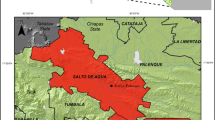Abstract
The shortened fallow period in traditional slash and burn agriculture of the Maya of Quintana Roo, Mexico, has reduced soil fertility, crop yields, biodiversity, and mature forest vegetation. Studies have shown that agroforests that mimic local ecosystem processes can be used to provide for the farmers' well-being while protecting and preserving forest resources and biodiversity. The objective of this investigation was to identify, describe, and evaluate Mayan crop plants that could be used as analog species in agroforest design. We used participant observation, interviews with farmers, and field measurements to collect information on the social, agricultural, and ecological aspects of the plants. We identified five horizontal and one vertical strata in mature homegardens: the herbaceous stratum, the low shrub stratum, the tall shrub stratum, the fruit tree stratum, the timber tree stratum, and the viny stratum. We categorized 77 forbes, shrubs, and vines identified for their temporal and spatial placement in an agroforest. The plants evaluated can be placed in one of the four developmental stages of an agroforest: the herbaceous stage, and the shrub stage, the fruit tree stage, and the timber tree stage. By using the identified plants and the analog hypothesis, we can design an agroecological system that provides for the farmers' needs, and efficiently utilizes the resources on-site for the production of food, timber, medicinal plants, and nontimber products in a manner that protects the natural resource base of the region.
Similar content being viewed by others
References
Achuthan Nair M and Sreedhatan C (1986) Agroforestry farming systems in the homesteads of Kerala, southern India. Agrofor Sys 4: 399-363
Bernard HR (1994) Research methods in anthropology, qualitative and quantitative approaches. 2nd ed. Sage Publications, CA, 584 pp
Cabrera-Cano E, Torres Pech SA, Gómez-Varela CS, Sánchez O, Serralta Peraza L and Herrera Escudero P (1991) Lista floristica del sureste del estado de Quintana Roo. In: Luhrs-Camarena T and Salazar-Vallejo S (eds) Estudios ecológicos preliminares de la zona sur de Quintana Roo, pp 11-19. Centro de Investigaciones de Quintana Roo, Chetumal, Mexico
Carlquist S (1991) Anatomy of vine and liana stems: a review and synthesis. In: Putz FE and Mooney HA (eds) The biology of vines, pp 53-72. Cambridge University Press, Cambridge
Darwin C (1875) The movements and habits of climbing plants, 2nd ed. John Murray, London
Del Amo RS and Ramos PJ (1993) Use and management of secondary vegetation in a humidtropical area. Agrofor Sys 21: 27-42
Denevan WM, Treacy JM, Alcorn JB, Padoch C, Denslow J and Flores Paitan S (1984) Indigenous agroforestry in the Peruvian Amazon: Bora Indian management of swidden fallows. Interciencia 9: 346-357
Ewel J (1980) Tropical succession: manifold routes to maturity. Biotropa 12: 2-7 (Supplement, Tropical Succession)
Fernandes ECM and Nair PKR (1986) An evaluation of the structure and function of tropical homegardens. Agric Sys 21: 279-310
Gliessman SR, Garcia RE and Amador MA. (1981) The ecological basis for the application of traditional agricultural technology in the management of tropical agro-ecosystem. Agro-Ecosystems 7: 173-185
Hart RD (1980) A natural ecosystem analog approach to the design of a successful crop system for the tropical environments. Biotropa 12: 73-83 (Supplement, Tropical Succession)
Michon G, Bompard J, Heckersweiler P and Ducatillon C (1983) Tropical forest architectural analysis as applied to agroforests in the humid tropics: the example of traditional villageagroforests in West Java. Agrofor Sys 1: 117-129
Mooney HA, Field C and Vasquez-Yanes C (1983) Photosynthetic characteristics of wet tropical forest plants. In: Medina E, Mooney HA and Vazquez-Yanes C (eds) Physiological ecology of plants of the wet tropics, pp 113-127. Dr. W. Junk Publishers, The Hague
Negreros-Castillo P, Avila M and Magaña M (1995) Fallow vegetation in the tropics: an opportunity for sustainable management through agroforestry. Women in Nat Res 17: 32-53
Okoli POS and Wilson GF (1986) Response of cassava (Manihot esculenta Crantz) to shade under field conditions. IITA, Nigeria
Oldeman RAA (1983) The design of ecologically sound agroforests. In: Huxley PA (ed) Plant research and agroforestry, pp 173-207. ICRAF, Nairobi
Salick J (1992) Amuesha forst use and management: an integration of indigenous use and natural forest management. In: Redford KH and Padoch C (eds) Conservation of neotropical forests working from traditional resource use, pp 305-332. Columbia University Press, New York
Standley PC and Williams LO (1973) Flora of Guatemala. Field Museum of Natural History, Chicago
Torquebiau E (1992) Are tropical agroforestry homegardens sustainable? Agri Ecosys and Environ 41: 189-207
Watters RF (1971) Shifting cultivation in Latin America. FAO Forestry Development Paper No. 7. Food and Agriculture Organization, Rome
Zomlefer W (1994) Guide to flowering plant families. University of North Carolina Press, Chapel Hill
Author information
Authors and Affiliations
Rights and permissions
About this article
Cite this article
De Clerck, F.A.J., Negreros-Castillo, P. Plant species of traditional Mayan homegardens of Mexico as analogs for multistrata agroforests. Agroforestry Systems 48, 303–317 (2000). https://doi.org/10.1023/A:1006322612362
Issue Date:
DOI: https://doi.org/10.1023/A:1006322612362




